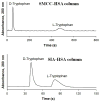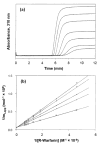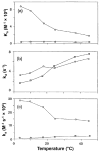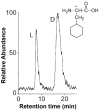Chromatographic Studies of Protein-Based Chiral Separations
- PMID: 28344977
- PMCID: PMC5363960
- DOI: 10.3390/separations3030027
Chromatographic Studies of Protein-Based Chiral Separations
Abstract
The development of separation methods for the analysis and resolution of chiral drugs and solutes has been an area of ongoing interest in pharmaceutical research. The use of proteins as chiral binding agents in high-performance liquid chromatography (HPLC) has been an approach that has received particular attention in such work. This report provides an overview of proteins that have been used as binding agents to create chiral stationary phases (CSPs) and in the use of chromatographic methods to study these materials and protein-based chiral separations. The supports and methods that have been employed to prepare protein-based CSPs will also be discussed and compared. Specific types of CSPs that are considered include those that employ serum transport proteins (e.g., human serum albumin, bovine serum albumin, and alpha1-acid glycoprotein), enzymes (e.g., penicillin G acylase, cellobiohydrolases, and α-chymotrypsin) or other types of proteins (e.g., ovomucoid, antibodies, and avidin or streptavidin). The properties and applications for each type of protein and CSP will also be discussed in terms of their use in chromatography and chiral separations.
Keywords: chiral high-performance liquid chromatography (HPLC); chiral recognition; chromatographic studies of drug-protein interactions; frontal analysis; protein-based chiral stationary phases; zonal elution.
Conflict of interest statement
Conflicts of Interest: The authors declare no conflict of interest.
Figures






References
-
- Pasteur L. Mémoire sur la relation qui peut exister entre la forme cristalline et la composition chimique, et sur la cause de la polarisation rotatoire. [Note on the relationship of crystalline form to chemical composition, and on the cause of rotatory polarization.] C R Séances Acad Sci. 1848;26:535–538.
-
- Drayer D. The early history of stereochemistry. In: Wainer IW, editor. Drug Stereochemistry, Analytical Methods and Pharmacology. 2. Marcel Dekker; New York, NY, USA: 1993. pp. 5–14.
-
- Patel S, Wainer IW, Lough WJ. Affinity-based chiral stationary phases. In: Hage DS, editor. Handbook of Affinity Chromatography. 2. CRC Press; Boca Raton, FL, USA: 2006. pp. 571–592.
-
- Okamoto Y. Helical polymers for efficient enantiomer separation. Adv Polym Sci. 2013;261:391–414.
-
- Hyun MH, Cho YJ. Chiral Separation by HPLC with Pirkle-Type Chiral Stationary Phases. In: Gübitz G, Schmid MG, editors. Chiral Separations: Methods and Protocols. Humana Press; Totowa, NJ, USA: 2004. pp. 197–205. - PubMed
Grants and funding
LinkOut - more resources
Full Text Sources
Other Literature Sources
